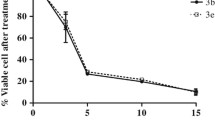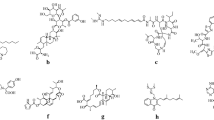Abstract
The mycolic acid compositions of Nocardia rubra and related bacteria grown in media containing different concentrations of antituberculous isonicotinic acid hydrazide (INH) were determined in detail by gas chromatography-mass spectrometry. On the basis of molecular species composition, average carbon numbers of mycolic acids were calculated. In Nocardia rubra, N. lutea and Rhodococcus rhodochrous IFO-13161, the ratio of mycolic to non-mycolic fatty acids and the average carbon numbers of mycolic acids were decreased at the INH concentrations of higher than 1 μg/ml, paralleling with the significant inhibition of growth. In above three species the synthesis of longer chain mycolic acids (longer than C44 or C46) was inhibited more significantly than shorter homologues such as C38 or C40. In contrast, neither growth inhibition nor change in corynomycolic acid composition was observed in Corynebacteria xerosis and Rhodococcus rhodochrous IFO-13165 at the concentration region of INH up to 100 μg/ml. The direct mass fragmentographic analysis of the trimethylsilylated (TMS) derivatives of mycolic acid methyl esters, monitoring [M-15] ions of individual molecular species, revealed that the chain shortening of total mycolic acid molecule by INH occurred more greatly in more highly unsaturated subclasses than in less unsaturated subclasses. Furthermore, mass fragmentographic analysis, monitoring fragment ions (A) and (B), due to straight chain and branched chain alkyl units, respectively, demonstrated the inhibition of mycolic acids was not attributed to the shortening of α-alkyl chain, but to the inhibition of chain elongation of C28 to C32 straight chain meromycolic acids. It was also indicated the amounts of trehalose mono- and di-mycolate (cord factor) decreased significantly with the addition of INH (1 to 20 μg/ml) in the above strains. From the results obtained above, INH appeared to inhibit the synthesis of mycolic acids longer than C44 or C46 specifically by inhibiting chain elongation or desaturation of precursor long chain fatty acids longer than C28 or C30.
Similar content being viewed by others
References
Barclay WR, Ebert RH, Koch-Weser D (1953) Mode of action of isoniazid. Am Rev Tuberc 67:490–496
Barclay WR, Koch-Weser D, Ebert RH (1954) Mode of action of isoniazid, part II. Am Rev Tuberc 70:784–792
Beaman BL, Bourgeois AL, Moring SE (1981) Cell wall modification resulting from in vitro induction of L-phase variants of Nocardia asteroides. J Bacteriol 148:600–609
Beggs WH, Jenne JW (1967) Mechanism for the pyridoxal neutralization of INH action on M. tuberculosis. J Bacteriol 94:793–797
Bekierkunst A, Bricker A (1967) Studies on the mode of action of isoniazid on mycobacteria. Arch Biochem Biophys 122:385–392
Bordet C, Michel G (1969) Structure et biogenèse des lipides a haut poids moléculaire de Nocardia asteroides. Bull Soc Chim Biol 51:527–547
Canal N, Garattini S (1957) Inhibition of glutamic acid decarboxylase by INH. Arzneimittel Forsch 7:158–159
Davidson LA, Takayama K (1979) Isoniazid inhibition of the synthesis of monounsaturated long-chain fatty acids in Mycobacterium tuberculosis H37Ra. Antimicrob Agents Chemother 16:104–105
Davison AN (1956) The mechanism of inhibition of decarboxylases by INH. Liver cystein sulphinic acid decarboxylase. Biochim Biophys Acta 19:131–140
Dittmer JC, Wells MA (1969) Quantitative and qualitative analysis of lipids and lipid components. Serine and ethanolamine. In: Lowenstein JM (ed) Methods in enzymology, vol 14. Academic Press, New York London, pp 502–504
Gayathri Devi B, Ramakrishnan T, Gopinathan KP (1972) Enzymatic interaction between INH and NAD. Biochem J 128:63p
Kates M (1972) Techniques of lipidology. Isolation, analysis and identification of lipids. In: Laboratory techniques in biochemistry and molecular biology, vol 3. North-Holland, Amsterdam London, pp 269–610
Maekura R, Ueno H, Kusunose E, Yano I, Kusunose M (1982) Enzymatic synthesis of very long chain fatty acids by Nocardia rubra. Proceedings for Japanese Conference of Biochemistry of Lipids 24:305–308
Michel G, Bordet C, Lederer E (1960) Isolément d'un nonvel acide micolique: l'acide nocardique a parter d'un souche de Nocardia asteroides. C R Acad Sc Paris 250:3518–3520
Minnikin DE, Goodfellow M (1976) Lipid composition in the classification and identification of nocardiae and related taxa. In: Goodfellow M, Brownwell GH, Serrano JA (eds) The biology of the Nocardiae. Academic Press, New York London, pp 160–169
Sakai J (1954) The mechanism of bacteriostatic action of INH. The influence of INH on transaminase of BCG. Kekkaku 29:161–165
Schaefer WB (1960) Effect of INH on the dehydrogenase activity of M. tuberculosis. J Bacteriol 79:236–245
Sriprakash KS, Ramakrishnan T (1970) INH-resistent mutants of M. tuberculosis R37RV: Uptake of INH and properties of NADase inhibitor. J Gen Microbiol 60:125–132
Takayama K, Schnoes HK, Armstrong EL, Boyle RW (1975) Site of inhibitory action of isoniazid in the synthesis of mycolic acids in Mycobacterium tuberculosis. J Lipid Res 16:308–317
Takayama K, Wang L, David HL (1972) Effect of isoniazid on the in vivo mycolic acid synthesis, cell growth, and viability of Mycobacterium tuberculosis. Antimicrob Agents Chemother 2:29–35
Tomiyasu I (1982) Mycolic acid composition and thermally adaptative changes in Nocardia asteroides. J Bacteriol 151:828–837
Tomiyasu I, Toriyama S, Yano I, Masui M (1981) Changes in molecular species composition of nocardomycolic acids in Nocardia rubra by the growth temperature. Chem Phys Lipids 28:41–54
Toriyama S, Yano I, Masui M, Kusunose M, Kusunose E (1978) Separation of C50–60 and C70–80 mycolic acid molecular species and their changes by growth temperature in Mycobacterium phlei. FEBS Lett 95:111–115
Winder F (1964) Early changes induced by INH in the composition of M. tuberculosis. Biochim Biophys Acta 82:210–212
Winder FG, Brennan P, Ratledge C (1964) Synthesis of fatty acids by extracts of Mycobacteria and the absence of inhibition by isoniazid. Biochem J 93:636–640
Winder FG, Collins PB (1970) Inhibition by isoniazid of synthesis of mycolic acids in M. tuberculosis. J Gen Microbiol 63:41–48
Yano I, Saito K, Furukawa Y, Kusunose M (1972) Structural analysis of molecular species of nocardomycolic acids from Nocardia erythropolis by the combined system of gas chromatography and mass spectrometry. FEBS Lett 21:215–219
Yano I, Kageyama K, Ohno Y, Masui M, Kusunose E, Kusunose M, Akimori N (1978) Separation and analysis of molecular species of mycolic acids in Nocardia and related taxa by gas chromatography mass spectrometry. Biomed Mass Spectrom 5:14–24
Yoneda M, Asano M (1953) Competitive action of isonicotinic acid hydrazide and pyridoxal in the amino acid decarboxylation of Escherichia coli. Science 117:277–279
Yoneda M, Kato N, Okajima M (1952) Competitive action of isonicotinic acid hydrazide and vitamin B6 in the formation of indole by E. coli. Nature 170:803
Youatt J (1958) The action of INH on the transaminases of M. tuberculosis (BCG). Biochem J 68:193–197
Youatt J (1969) A review of the action of isoniazid. Am Rev Respirat Diseases 99:729–749
Author information
Authors and Affiliations
Rights and permissions
About this article
Cite this article
Tomiyasu, I., Yano, I. Isonicotinic acid hydrazide induced changes and inhibition in mycolic acid synthesis in Nocardia and related taxa. Arch. Microbiol. 137, 316–323 (1984). https://doi.org/10.1007/BF00410728
Received:
Accepted:
Issue Date:
DOI: https://doi.org/10.1007/BF00410728




